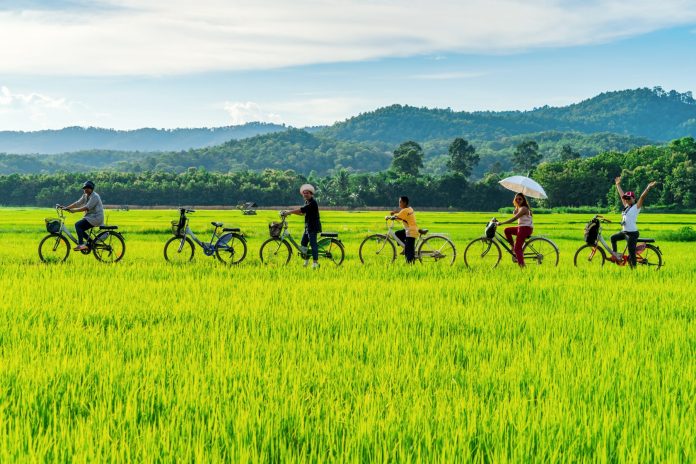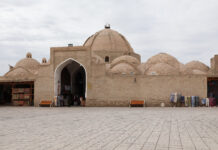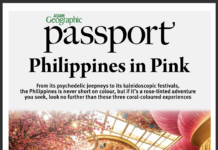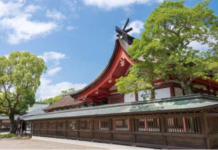
Sukhothai offers a taste of ancient Thai civilisation, agrarian living, and local hospitality
Text and Photos Alex Campbell
Sukhothai translates to “dawn of happiness” our guide, Tong, tells us with an appropriately wide grin as we pull out of the airport on a steaming, cloudless day in February. It’s the
end of the dry season, and a milky Thai iced tea (Cha Yen ชาเย็น) – a shock of saccharine, foamy orange – goes down a treat. The lazy yawns I’ve been stifling since the early morning wake-up are swiftly substituted with a caffeine and condensed milk-induced buzz.
It’s my second time to the north of Thailand, and a lot has changed since. Back in 2011, I was making my way to Chiang Mai through swamped floodlands, and the late King Bhumibol was ruler; evidence of the former devastation has vanished, but the legacy of the latter lines the streets in silky swaths of black mourning banners. The beloved sovereign’s portrait flanks that of his son, newly crowned King Maha Vajiralongkorn Bodindradebayavarangkun, or Rama X.
Sleepy Sukhothai offers a reprieve from the throngs of tourists that descend on the gritty city of Bangkok. The quiet old town, while still host to all the conveniences that the modern traveller has come to expect, has not succumbed to touts and excess in the wake of tourist interest. The agrarian lifestyle of this community is still active and widely visible: Sluggish water buffalo amble by the roadside; rice farmers wade through lush paddies under the shade of their iconic, conical hats; and fruit sellers brandish banana bunches and bags of rambutans with an auctioneer’s enthusiasm. It comes as little surprise, then, that Sukhothai is surrounded by water – 175 ponds, to be exact. The system of reservoirs provides the surrounding agricultural heartlands with a steady supply of irrigation – and keen photographers with the perfect mirror for capturing dramatic temple reflections. However, the original construction of this labyrinth of waterways was for protection against invading enemies: Sukhothai stood as the capital of the first Kingdom of Siam in the 13th and 14th centuries (1248–1439 AD), followed by Ayutthaya (around 1350–1767), Thonburi (1767–1782)
and Bangkok, which claimed the title in 1782, and holds it today. Beyond the moats’ more militant purpose, they also provide meuang gòw – the “old city” – with a picturesque home for various waterbirds, which are often seen stalking fish among the luminous pink lotus flowers – a Buddhist symbol for enlightenment.
The Sukhothai Historical Park covers a vast area of around 45 square kilometres, home to ruins from the era that historians consider as “the golden age” of Thailand. The Sukhothai period was seminal in the establishment of Buddhism in the country, introducing Hinayana Buddhism from Ceylon (what is today Sri Lanka). The World Heritage Site, recognised by UNESCO in 1991, is a showcase of classic Thai-style architecture, with strong influence from Sinhalese design and Khmer art. The impact of Indian theology is also evident in many of the monuments: Besides the anticipated Buddha images, carvings of Hindu gods are abundant, owing to extensive influence from Brahmanic deities at the time. The kingdom also borrowed much of its art and sculpture from the Gupta period.

That being said, Sukhothai remains quintessentially Buddhist, and its construction ushered in designs that would become the prototypes of Thai architecture: the wat, or monastery; viharas, or temples; the stupa; and stone imaginings of the Buddha – sitting, walking and reclining.
The best way to explore the historical park is by bicycle. The landscape is, somewhat surprisingly, a far cry from your typical Southeast Asian jungle vegetation: Covered in towering trees such as the Chan, a species of dragon tree (Dracaena kaweesakii), the landscaping feels reminiscent of a setting in a Hans Christian Andersen story – mythical, even eerie at times in its quiet, making it a haven for culottes-donning meditators. Wat Mahathat is the iconic viewpoint from which to watch the sunset. As the sun dips behind the horizon, the skyline of stupas forms the perfect silhouette – and photographers know it. While this is the most visited temple in the complex, it’s blissfully peaceful compared to Cambodia’s Angkor Wat, which is consistently populated with hordes of visitors sporting selfie sticks. In comparison, the gardens surrounding Wat Mahathat allow visitors to claim a grassy spot and sit in relative solitude as the crickets sound out the end of the day, and the heat sinks into balmy evening.
For visitors looking to see out the end of the day in an even quieter location – without forfeiting a view of historical grandeur – the lesser known Sri Satchanalai (which translates to “city of good people”) – the second centre of the Sukhothai kingdom, and the former residence of the crown prince – is a magnificent alternative. Several temples, such as Wat Chang Lom, Wat Chedi Chet Thaiw and Wat Phra Sri Rattana Mahathat, have been painstakingly restored, allowing visitors a window to their glorious past. The sheer immensity of this area’s history is something of a rabbit hole, and if you feel like taking a tumble down it, the best place to do so is at the Ramkhamhaeng National Museum just outside the Sukhothai Historical Park. This carefully curated collection houses Khmer statues and Sukhothai Buddhas, Sawankholok ceramics and artefacts collected from the tributary cities of Sri Satchanalai, Kampaeng Petch, Petchaboon and Pijit.

All the cycling and walking is bound to work up an appetite, and Thailand is quite adept at living up to its reputation for phenomenal food. But forget your stock standard orders of Thai green curry and pad Thai of the mainstream Khaosan variety – the cuisine of the north has stashed some other ingredients in its pantry. I am notoriously indecisive when it comes to ordering food from long-form menus, and so I’m a ready fan of establishments that do a handful of dishes – and do them well.
In Ban Na Ton Chan (บ้านนาต้นจั่น), a remote little village near Sri Satchanalai, one such restaurant serves up three signature dishes, the first being khao perb – or khao poep – a recipe that is unique to the district. Crepe-like flour noodles, coriander, lettuce, bean sprouts, garlic, and a sunnyside-up egg (which is craftily steamed on a piece of cloth over boiling water) converge in a flavourful hot broth. The second offering is goi teo bae, a dry noodle, served up on a banana leaf with a sliver of pork, the obligatory side serving of crushed peanuts and lime, and a sneak treat of pork crackling. The final meal on the menu is a selection of lolly-like mee pun, a variety of colourful rice noodle wrapped around slivery strands of vermicelli and mung bean sprouts, cleverly wound onto a stick. The latter was more aesthetically pleasing than anything else: The purple and orange noodles flecked with black spice freckles look more like a type of candy you would sport at a funfair than a glutinous savoury snack.

Ban Na Ton Chan offers a grassroots gateway to community culture, and a few intimate homestays have cropped up to cater to travellers looking to engage in the local way of life. One such activity is a weaving operative. Cotton threads are dyed with natural ingredients such as jackfruit bark and mangosteen peel, and then woven on looms into textile designs. The material is then fermented overnight – in vats of mud. The result is a cashmere-soft product, which is fashioned into various clothing. Tong tells me that the softening properties of mud were discovered by women working in the rice fields. They noticed that the hems of their skirts, inches deep in mud during the working day, were much softer than the upper part of their garments after washing, and so they turned mud fermented fabric making into a local cottage industry.
The Sri Satchanalai district is also home to the Gold Textile Museum of Lung Sathorn, locally famous for their handwoven women’s sarongs, and Ban Thong Somsamai (ร้านทองสมสมัย), where jewellery artisans design intricate gold pieces sold in front of the factory.Creatively inclined visitors can also pay a visit to Prasert Antique, a craft shop that specialises in sangkhalok (สังคโลก) – a type of ceramic ware, and Sukhothai’s most famous export – which visitors can design themselves; a steady hand is required.
Often as not, when the time comes to leave, there’s an air of anticlimactic despondency at the prospect of seeing out the last couple of hours of a place stuck in an overly air-conditioned airport with an overpriced drink. But Sukothai Airport – privately owned by Bangkok Airways – has been shrewdly intuitive in establishing its Organic Agricultural Project a mere five minutes from the runway. Putting community work into practice, you can don a set of farmer’s kit in a royal shade of purple, hop aboard the rural vehicle of choice –
an ee đăan – and gather duck eggs, plant rice seedlings, and cap it off with a fantastic meal sourced directly from the garden in the Krua Sukho organic restaurant (the collected duck eggs make their way in there, too).
The combination of centuries-old history, warm hospitality, and community-supported initiatives has put Sukhothai on the traveller’s map – but the drop pin is still just far enough off the beaten banana pancake trail to allow its quiet, bucolic character to remain authentic, and unspoiled.
For more stunning stories and photos, check out Asian Geographic Issue 125.










